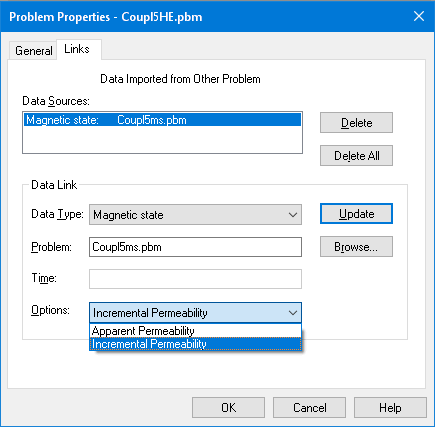
Fig. Magnetic import dialog.
QuickField is capable of importing loads (distributed sources) calculated in some problem into the problem of another type. Following coupling types are supported:
In addition to imported loads, you can define any other loads and boundary conditions, similar to non-coupled problem.
You can combine several coupling types in one problem. E.g., after calculating currents distribution, electrostatic and magnetic fields as separate problems based on the same model file, you can calculate temperature distribution from Joule heat and then find stresses caused by temperature and magnetic and electric forces at once. However, such problems are rather rare.
Further we will call the problem, from which the data are being loaded, the source problem, and the problem, which imports the data, the target problem.
There are several rules to follow with coupled problems:
Note. In spite of the requirement that coupled problems must use the same model file, the geometrical region for the problems need not coincide, i.e. some subregions those are in use in one problem, could be excluded from consideration in the other one.
While importing data from DC or AC conduction problem to heat transfer one, heat sources due to Joule law are assumed in all subregions included into consideration in both source and target problems. In transient or AC magnetic problems, Joule heat is generated in all conductors. When importing Joule heat from transient magnetic problem into transient heat transfer, both processes are assumed to run synchronously. With this feature, you can simulate time-dependent heat distribution arising from time-dependent electric current distribution (including eddy currents) in a magnetic device.
While calculating thermal stresses, initial strains are assumed in all subregions, which are included into consideration in both problems and possess nonzero value of thermal expansion coefficient (or at least one of its components in anisotropic case). While importing the temperature distribution from the transient problem, you can choose the moment of time, the state at which you wish to import.
While importing magnetic force to stress analysis problem:
While importing the magnetic forces from the transient problem, you choose the moment of time, the state at which you wish to import.
While importing electric force to stress analysis problem:
QuickField is able to remember the magnetic state of the media in the source problem
for further use in target problems, where it is necessary to take into account the actual
magnetic saturation.
Quantity, transferred from DC Magnetic problem is the value of magnetic
permeability, calculated in every finite element of the source problem.
Taking into account that there are two types of magnetic permeability - apparent (static) and incremental (differential), the import dialog has a switch for selecting proper type of imported parameters. It should be mentioned that the choice between apparent and incremental permeability for importing depends on the application.
 |
Fig. Magnetic import dialog. |
Target problem will become linear, and the magnetic permeability values entered into the target problem description
will be ignored and replaced by imported data. Magnetic state remembering is equivalent to the working point fixation for magnetic system.
This gives the possibility to calculate the differential mutual and self-inductances of multi-coil system in the target problems,
by calculating the magnetic flux induced by current in only one of coils at time.
QuickField allows importing the calculated temperature field into a problem of AC magnetics. This temperature field may be then used for calculating the values of the electrical conductivity for materials where the conductivity is temperature-dependent.
Related Topics
Coupled (Multiphysics) Examples